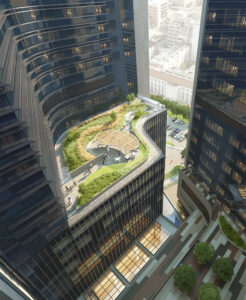
Embedded within the ethos of responsible development, reminiscent of the principles articulated in the Hippocratic Oath, is a compelling argument for land developers and civil engineers to champion Sustainable Infrastructure. This transformative paradigm transcends conventional environmental concerns, extending into the interconnected realms of community well-being, resilience against environmental challenges, and the economic viability of projects.
Houston Methodist, and other health care providers are actively engaging specialized teams to comprehend and mitigate the multifaceted impact of infrastructure and development on human health. Developers and engineers have the power to shift this narrative by choosing what the future of infrastructure looks like as the region continues to grow. There is a value to all to consider a shift to a broader perspective that aligns with their goals and social responsibilities.
Understanding the diverse facets of community well-being, health care professionals are tasked with grappling not only with environmental considerations but also with less traditionally considered concepts, such as the health effects of flooding. Home displacement and property destruction implicates poor mental and physical health outcomes while uncontrolled mosquito populations lead to diffusion of current and emerging diseases.
 Incorporating a circular understanding of hospital operations and our community, Houston Methodist seeks to compost food waste to mitigate greenhouse gases while supporting development of community practices to reduce flood risk. Application of compost to landscaping could decrease clay and soil compaction resulting in reduced water runoff while promoting less landscape irrigation as soil absorption increases up to 12 to 18 inches. Houston Methodist’s main campus in the Texas Medical Center is incorporating a 14th floor healing garden in the construction of its 29-story Centennial Tower that reduces runoff while incorporating nature views for patients and as well as a place of respite for nurses and visitors. Additionally, Houston Methodist Sugar Land is leading its team in the development of an educational community garden for staff and visitors incorporated into its campus. Sustainable Infrastructure becomes a strategic tool to address the mental and physical health implications of flooding.
Incorporating a circular understanding of hospital operations and our community, Houston Methodist seeks to compost food waste to mitigate greenhouse gases while supporting development of community practices to reduce flood risk. Application of compost to landscaping could decrease clay and soil compaction resulting in reduced water runoff while promoting less landscape irrigation as soil absorption increases up to 12 to 18 inches. Houston Methodist’s main campus in the Texas Medical Center is incorporating a 14th floor healing garden in the construction of its 29-story Centennial Tower that reduces runoff while incorporating nature views for patients and as well as a place of respite for nurses and visitors. Additionally, Houston Methodist Sugar Land is leading its team in the development of an educational community garden for staff and visitors incorporated into its campus. Sustainable Infrastructure becomes a strategic tool to address the mental and physical health implications of flooding.
The Center for Health & Nature, a collaborative venture between Houston Methodist, Texas A&M University and Texan by Nature, is leading research efforts to bolster the evidence linking the impact of our environments on health and well-being. Within the context of medicine, design and access to nature and greenspaces for our growing communities is as equally important as the concept of prescribing time in nature for the sustainability of community health and patient well-being. Ensuring that developments are resilient and attuned to the well-being of their inhabitants therefore has long term health ramifications. Moreover, the positive impact of green spaces on community well-being is recognized as a critical health determinant.
At Houston Methodist Cypress Hospital, our 90-acre campus along Cypress Creek supports this moral imperative as it connects its hike and bike trails with local communities and introduces sports fields for community access while addressing site specific flood mitigation. Sustainable Infrastructure, in the hands of land developers, urban planners and civil engineers, translates into the creation and preservation of accessible parks and green areas. Inclusive access promoting community well-being through Sustainable Infrastructure involves strategic interventions that align with the broader societal context.
Developers, attuned to the needs of local populations, engage in transparent collaboration with communities to tailor sustainable solutions that resonate with and benefit the inhabitants. Recognizing the economic and social value of trails and green spaces, these professionals become stewards of projects that contribute not only to the physical landscape but also to the mental and social fabric of communities.

The commitment to understanding and mitigating the broad impacts of operations becomes a compelling model for professionals in land development and civil engineering. By elucidating complex pathways and identifying high-impact areas for intervention, these professionals are empowered to adopt Sustainable Infrastructure as a holistic approach that transcends environmental concerns, contributing to community resilience and well-being.
The value proposition lies not only in the ethical responsibility to “first, do no harm” but also in the economic and competitive advantages that arise from prioritizing Sustainable Infrastructure. Empirical evidence showcasing the benefits to ecosystem health, community well-being, and economic viability becomes a persuasive tool, spurring industry-wide adoption of technologies and best practices that align with the principles of responsible and sustainable development.
In this collaborative journey with the greater metropolitan landscape, developers, planners and engineers have the opportunity to integrate research outcomes with built environments. This synergistic approach ensures the development of nature-conscious communities, fostering well-being and resilience for current and future generations. Sustainable Infrastructure emerges not merely as a requirement but as a strategic imperative for those shaping the landscape of tomorrow, offering a competitive edge and a testament to the ethical and economic value of responsible development.
This piece was written collaboratively by Sadeer Al-Kindi, MD; Nwabunie Nwana, PhD, MPH, MBA; Jason Fischer, MBA. Houston Methodist Hospital. Published December 6, 2023
